You’re about to discover the secret weapon that’ll transform your yard into a thriving ecosystem paradise. Virginia’s native plants don’t just survive here, they absolutely flourish in ways that’ll make your neighbors wonder what magic you’ve discovered. These botanical champions have spent thousands of years perfecting their survival strategies in your exact climate conditions. But here’s what most gardeners don’t realize about choosing the right species for their specific zone.
Contents
- 1 Virginia’s Diverse Hardiness Zones
- 2 Virginia’s Best Wildflower Selections
- 3 Virginia’s Champion Native Trees
- 4 Virginia’s Hardy Native Shrubs
- 5 Selecting the Right Native Plants for Your Garden
- 6 Frequently Asked Questions
- 6.1 How Much Do Native Virginia Plants Typically Cost Compared to Non-Native Varieties?
- 6.2 When Is the Best Time of Year to Plant Native Species?
- 6.3 How Often Should I Water Newly Planted Native Virginia Plants?
- 6.4 Do Native Plants Require Special Fertilizers or Soil Amendments?
- 6.5 Where Can I Purchase Authentic Native Virginia Plants in My Area?
Virginia’s Diverse Hardiness Zones
When you’re selecting native plants for Virginia, understanding the state’s hardiness zones becomes your roadmap to gardening success. Virginia spans four USDA zones from 5b to 8b, creating significant climate variability across the state. The northern tip reaches zone 5b with brutal -15°F minimum temperatures, while the eastern shore enjoys milder zones 8a and 8b.
Central Virginia sits primarily in zone 7, with most areas shifting to the warmer 7b classification in 2023’s updated map. This hardiness zone system uses 30-year averages of lowest winter temperatures, helping you choose plants that’ll survive your specific location’s coldest nights. The new map incorporates elevation factors, urban heat islands, and proximity to water bodies for more accurate zone designations.
Virginia’s Best Wildflower Selections
Virginia offers exceptional native wildflower diversity across seasons, from spring bloomers like trilliums to summer varieties, plus pollinator-friendly species and complementary native grasses for meadow plantings. Early spring brings delicate species like Anemonella thalictroides with its tiny, delicate flowers that herald the beginning of the growing season.
Virginia Bluebells
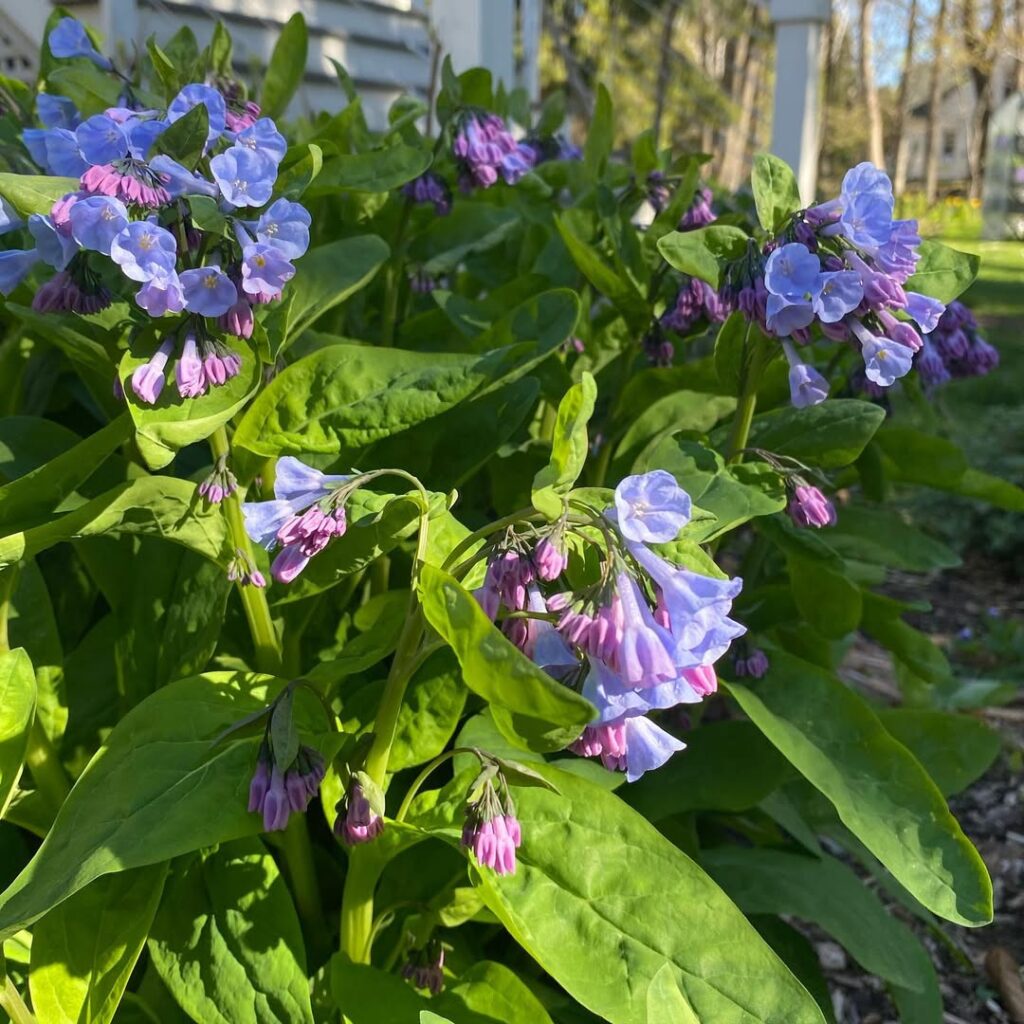
Virginia Bluebells (Mertensia virginica) are among Virginia’s most beloved spring wildflowers, creating stunning carpets of sky-blue blooms in woodland areas. These spring ephemerals emerge early in the season, producing clusters of bell-shaped flowers that attract native pollinators before going dormant by summer. Also known as eastern bluebells or Virginia cowslip, this member of the borage family naturally forms large colonies in rich, moist woodlands.
As a native perennial reaching up to 2 feet tall, Virginia Bluebells are perfectly adapted to the state’s climate and ecosystems. Their traditional medicinal uses by Native Americans and edible flowers add cultural significance to their ornamental value. The Royal Horticultural Society’s Award of Garden Merit recognizes their exceptional garden worthiness, making them an iconic choice for naturalizing in Virginia’s woodland gardens. These wildflowers combine beautifully with bleeding heart, celandine poppy, and Trillium grandiflorum in naturalized woodland settings.
- Hardiness: USDA zones 3-9
- Light: Part shade to full shade
- Water: High water requirements; prefers consistently moist conditions
- Soil: Rich, well-draining, moist soil; circumneutral pH 6.8-7.2; tolerates rocky soils
- Fertilizer: Minimal requirements in rich, organic soils
- Pest/Disease Resistance: Generally resistant with few significant issues
- Growth Rate: Moderate; spreads readily to form large colonies in suitable conditions
Wild Columbine
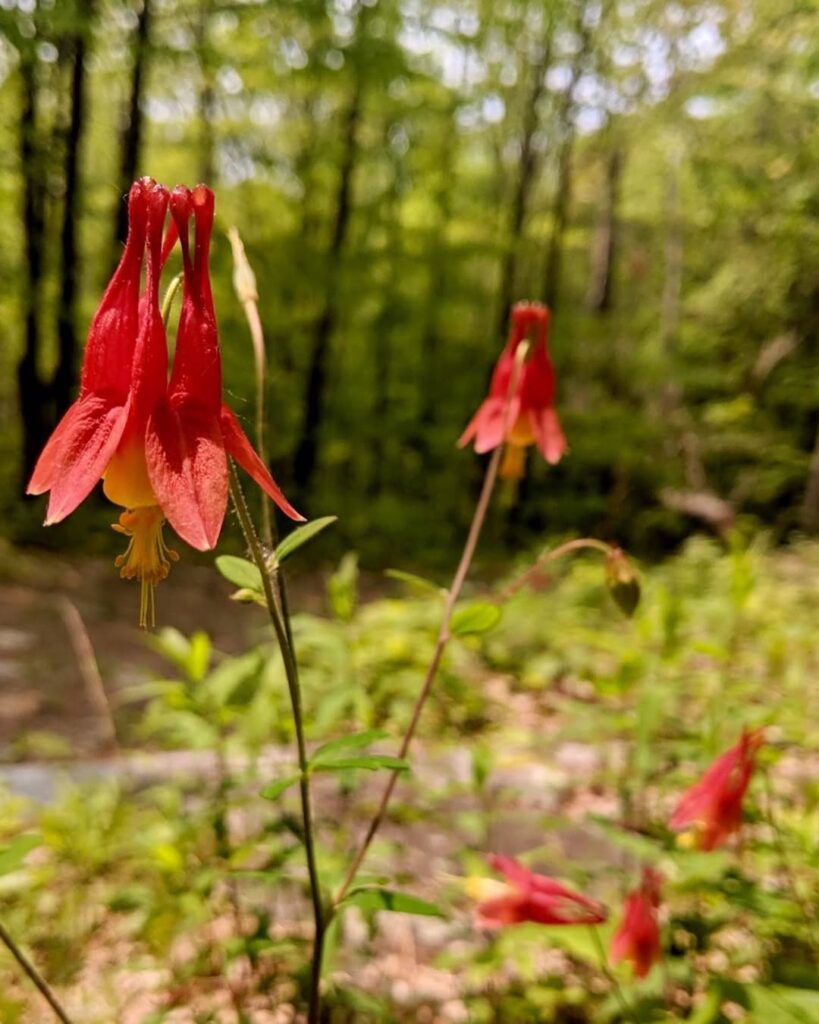
Wild Columbine is a delicate yet hardy perennial wildflower that graces Virginia’s woodlands with its distinctive nodding red and yellow flowers. Growing 1-2 feet tall, this native gem features spurred tubular blooms that create a spectacular display from April through May, attracting hummingbirds, bees, and butterflies. Its glaucous, blue-green foliage provides an attractive backdrop to the showy 2-inch flowers.
This woodland treasure thrives in Virginia’s rocky slopes, dry woodland areas, and exposed ledges, preferring partially shaded locations with well-draining soil. Wild Columbine’s clumping growth habit and semi-evergreen nature make it an excellent choice for naturalized gardens and wildlife habitats throughout most of Virginia. The plant belongs to the buttercup family, which includes approximately 60 genera and 2500 species worldwide.
- Hardiness: USDA zones 3a-8b
- Light: Full sun to partial shade (2-6+ hours of direct sunlight)
- Water: Moist to occasionally dry conditions; requires good drainage
- Soil: Clay, loam, or sand with neutral pH (6.0-8.0); prefers calcareous soils
- Fertilizer: Low requirements; avoid overly rich soils
- Pest/Disease Resistance: Generally resistant with proper growing conditions
- Growth Rate: Medium growth rate with medium maintenance requirements
Wild Bergamot

Wild Bergamot (Monarda fistulosa) is a stunning native Virginia perennial that serves as an ecological powerhouse in the landscape. This mint family member produces clusters of pink to lavender flowers from June through August, reaching heights of 3-5 feet when mature. Also known as Horsemint or Purple Bergamot, it supports 12 moth and butterfly species while attracting long-tongued bees, butterflies, and hummingbirds. Its aggressive spreading habit via rhizomes makes it ideal for naturalized areas and erosion control.
This adaptable wildflower thrives in diverse conditions from rich to poor soils and tolerates both sandy and clay compositions. Wild Bergamot’s deer resistance and ability to support specialist pollinators, including wasps that prey on invasive stink bugs, make it invaluable for native plant restoration projects across its wide natural range in North America. The plant’s aromatic leaves can be harvested to make a fragrant herbal tea with a bergamot orange-like scent.
- Hardiness: Native Virginia perennial, widely adapted across North America
- Light: Full sun to partial shade
- Water: Dry to medium moisture once established, moist during first year
- Soil: Adaptable to wide range from rich to poor, sandy to clay; prefers pH 6.8-7.2, tolerates 6.0-7.5
- Fertilizer: Not required due to adaptability to poor soils
- Pest/Disease Resistance: Deer resistant
- Growth Rate: Aggressive spreader via rhizomes, can colonize areas quickly
Wild Ginger
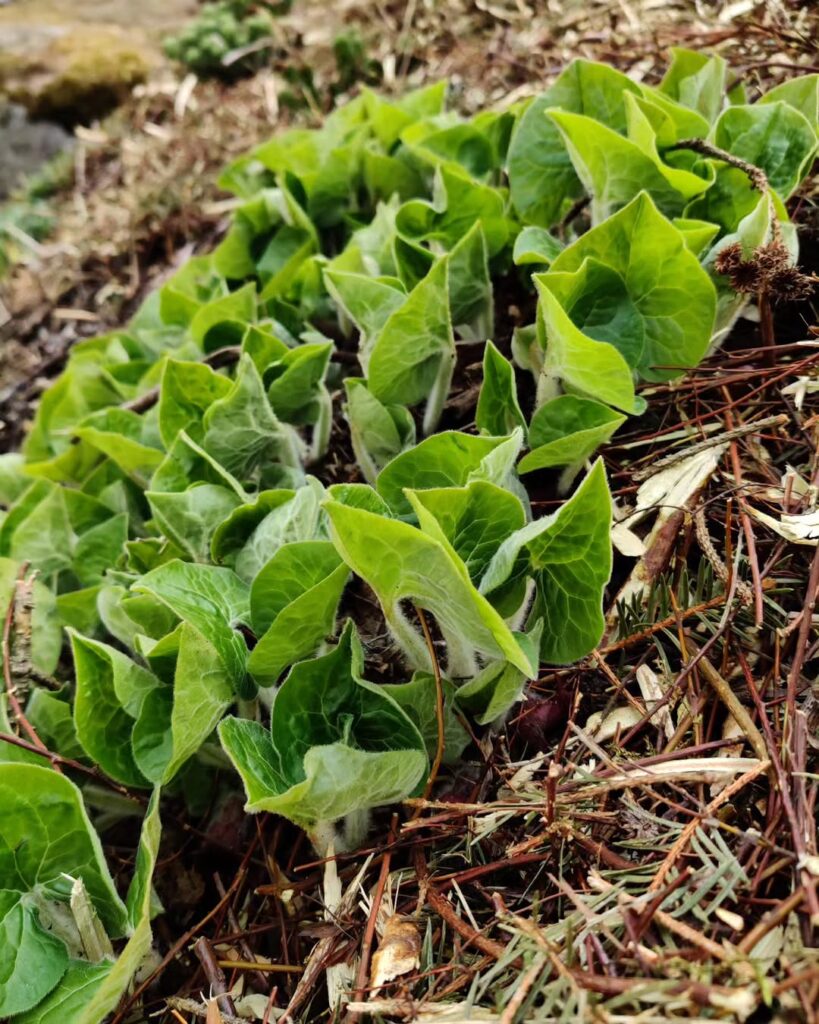
Wild ginger is a charming native perennial that forms low-growing colonies through branching rhizomes. This deciduous woodland plant produces distinctive kidney-shaped leaves that are soft and densely hairy, creating attractive 10-inch wide clumps. The plant’s most interesting feature is its small, dark bell-shaped flowers that bloom at ground level in spring, earning it the nickname “little brown jug” due to their unique appearance.
The flowers are strategically positioned beneath the foliage to attract small pollinating flies, while seeds are dispersed by ants attracted to their elaiosomes. Wild ginger serves as excellent ground cover in woodland gardens and naturalistic landscapes, complementing other native Virginia species while requiring minimal maintenance once established. The plant’s rhizomes and leaves contain ginger-like aroma that can be detected when scratched or crushed, making identification straightforward for gardeners.
- Hardiness: Native perennial suitable for Virginia’s climate zones
- Light: Shade to partial shade, thrives in woodland environments
- Water: Moderate moisture requirements, typical of woodland plants
- Soil: Well-draining woodland soil, adaptable to various soil types
- Fertilizer: Low fertilizer needs, benefits from natural organic matter
- Pest/Disease Resistance: Generally resistant to common pests and diseases
- Growth Rate: Moderate, spreads gradually through rhizomes to form colonies
Wild Lupine

Wild Lupine (Lupinus perennis) stands out as one of Virginia’s most spectacular native wildflowers, featuring striking blue-violet pea-like flowers arranged in tall racemes that bloom from April through May. This distinctive perennial showcases gray-green palmately-compound leaves with 7-11 lance-shaped leaflets arranged in an attractive pinwheel pattern.
Beyond its ornamental value, Wild Lupine provides exceptional ecological benefits through nitrogen-fixing root bacteria that enhance soil fertility. The flowers track the sun throughout the day, earning it the alternate name “Sundial Lupine,” while attracting bees, butterflies, and hummingbirds. Wild Lupine serves as the sole host plant for the endangered Karner Blue butterfly caterpillars, making its conservation critical for this rare species’ survival. Though increasingly rare in wild settings, this adaptable native thrives in poor soils where other plants struggle, making it invaluable for conservation gardens and naturalized landscapes.
- Hardiness: USDA zones 3-8
- Light: Full sun to light shade; benefits from partial shade in hot regions
- Water: Low to moderate; drought tolerant once established
- Soil: Dry, sandy, nutrient-poor, acidic soils with excellent drainage
- Fertilizer: None needed; nitrogen-fixing capabilities eliminate fertilizer requirements
- Pest/Disease Resistance: Generally resistant to most pests and diseases
- Growth Rate: Moderate; reaches 24 inches height and width at maturity
Virginia’s Champion Native Trees
Virginia’s Big Tree Program documents over 60 champion native trees of exceptional size and longevity, featuring notable oaks, maples, and other species that provide essential ecological and cultural benefits. These remarkable specimens serve as community landmarks and enhance landscape aesthetics while offering valuable educational opportunities for tree identification and conservation efforts throughout the state.
American Chestnut

The American chestnut once dominated Virginia’s forests as a towering giant reaching 100 feet tall, serving as a cornerstone species that fed countless wildlife with its nutritious nuts. This magnificent native tree was nearly wiped out by chestnut blight in the early 1900s, reducing billions of trees to struggling root sprouts.
Today, Virginia leads restoration efforts through dedicated research at Lesesne State Forest, working with universities and the American Chestnut Foundation to develop blight-resistant varieties. While functionally extinct in the wild, ongoing breeding programs and surviving root systems offer hope for returning this champion native tree to Virginia’s landscapes. The wood’s rot-resistance made it highly valued for furniture, fencing, and building materials before the blight devastated the population.
- Hardiness: USDA zones 4-8
- Light: Full sun to partial shade
- Water: Moderate moisture, drought tolerant once established
- Soil: Well-drained, slightly acidic soils preferred
- Fertilizer: Low requirements, benefits from organic matter
- Pest/Disease Resistance: Highly susceptible to chestnut blight; breeding programs focus on resistance
- Growth Rate: Fast-growing when healthy
Eastern Red Cedar

Eastern Red Cedar stands as one of Virginia’s most resilient and valuable native trees. This aromatic evergreen typically grows 30-40 feet tall with a distinctive pyramidal shape that becomes broader with age. Its gray-green to blue-green foliage provides year-round interest, while the fibrous, reddish-brown bark adds textural appeal to the landscape.
As a pioneer species, Eastern Red Cedar excels in challenging conditions where other trees struggle. It readily colonizes disturbed sites and provides essential wildlife habitat, offering nesting sites for birds and winter food through its pale blue berry-like cones. The tree has deep historical roots in Virginia, first documented at Roanoke Island in 1564, and continues to serve important ecological and practical functions today.
The tree’s versatility extends beyond ornamental use, serving as material for fence posts, furniture, and decorative carvings due to its naturally rot-resistant wood properties.
- Hardiness: Zones 2-9, tolerates temperature extremes
- Light: Full sun to light shade
- Water: Drought tolerant once established, handles occasional flooding
- Soil: Highly adaptable to poor, rocky, or varied soil types
- Fertilizer: None required, thrives in nutrient-poor conditions
- Pest/Disease Resistance: Excellent resistance except cedar-apple rust
- Growth Rate: Fast, early successional pioneer species
Flowering Dogwood
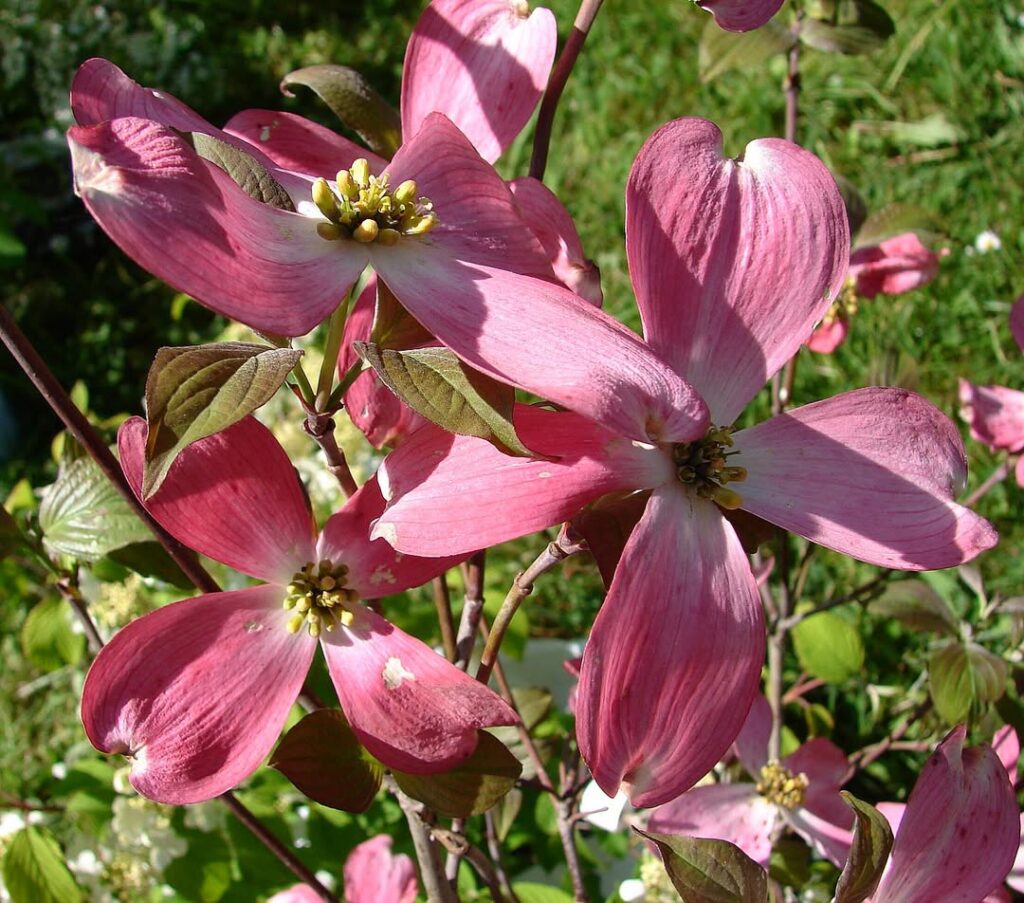
The flowering dogwood stands as Virginia’s beloved state tree and flower, representing the quintessential native understory species. This graceful small tree reaches 5-15 meters tall and captivates with its spring display of large white or pink bracts surrounding clusters of tiny yellow flowers. As it matures, the dogwood develops distinctive checkered bark resembling alligator hide and maintains an elegant horizontal branching pattern that provides year-round architectural interest.
Beyond its ornamental value, flowering dogwood serves as a vital wildlife plant, supporting over 100 butterfly and moth species while feeding 98 different bird species with its scarlet fall berries. The tree offers seasonal beauty from spring blooms through autumn’s maroon foliage and winter berry clusters, making it an exceptional choice for naturalistic landscapes. The hard, dense wood has been traditionally valued for specialized applications like golf club heads and mallets due to its exceptional durability.
- Hardiness: USDA zones 5-9
- Light: Partial shade to dappled sunlight; afternoon shade preferred
- Water: Consistent moisture required, especially in summer; avoid waterlogged conditions
- Soil: Neutral to slightly acidic, organically rich, well-draining; adapts to clay, loam, and sand
- Fertilizer: Minimal needs in organically rich soil; light spring application if needed
- Pest/Disease Resistance: Susceptible to dogwood anthracnose; generally hardy otherwise
- Growth Rate: Slow to moderate
Tulip Poplar
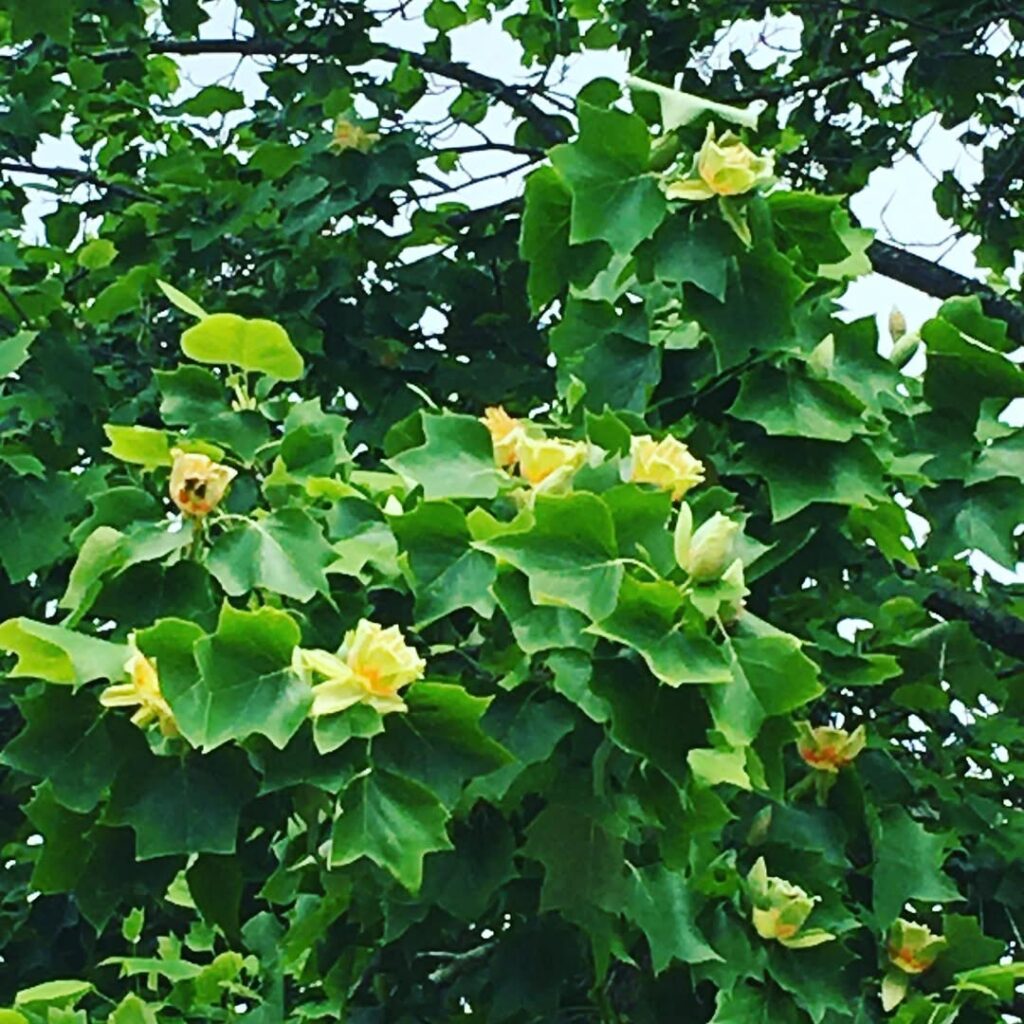
The Tulip Poplar (Liriodendron tulipifera) stands as one of Virginia’s most impressive native trees, consistently helping the state rank among the top five for documented champion trees with nearly 80 national champions. These majestic trees provide exceptional environmental benefits through their extensive canopies and root systems, effectively managing water cycles by capturing rainfall and reducing stormwater runoff that could carry harmful sediments into the Chesapeake Bay.
Beyond their water management capabilities, Tulip Poplars serve as natural air purifiers, capturing pollutants including ozone, carbon dioxide, and particulates. Their extensive canopies provide significant cooling effects in urban areas, offering shade that reduces the urban heat island effect and creates more comfortable environments for outdoor activities. At the end of their life cycle, these valuable native trees can be repurposed through Urban Wood movements rather than treated as waste, connecting communities to Virginia’s environmental heritage while serving as educational tools for raising awareness about native species importance.
- Hardiness: Cold hardy, seeds require stratification at 41°F for 60-90 days
- Light: Full sun, shade intolerant
- Water: Adequate irrigation needed, helps manage stormwater naturally
- Soil: Deep, rich, slightly acidic soil conditions
- Fertilizer: Benefits from proper nutrient management practices
- Pest/Disease Resistance: Susceptible to tuliptree aphids and scale when stressed; sooty mold can develop
- Growth Rate: Fast-growing when conditions are ideal
Red Maple
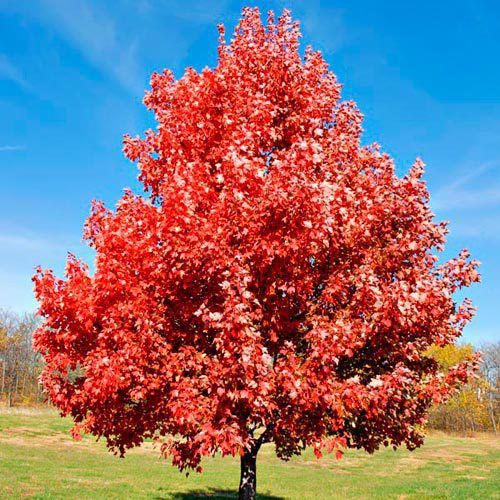
Red Maple stands as one of Virginia’s most spectacular native trees, earning recognition as a true champion for its adaptability and stunning seasonal display. Known locally as “swamp maple,” this medium to large deciduous tree can reach up to 100 feet tall with a rounded to vase-shaped crown. Its vibrant red flowers and twigs create early spring interest before leaves emerge, while the brilliant red to orange autumn foliage makes it one of Virginia’s most striking trees for fall color.
This versatile native thrives across diverse habitats from stream banks to upland woodlands, making it invaluable for both ecological and landscape purposes. Red Maple provides critical habitat for wildlife while supporting early-season pollinators with its flowers that appear before most other trees bloom. The tree serves as a larval host for the rosy maple moth, contributing to Virginia’s native ecosystem biodiversity. Its moderate growth rate, drought tolerance once established, and ability to handle urban conditions make it an excellent choice for Northern Virginia landscapes.
- Hardiness: Zones 3-9, native throughout eastern North America including Virginia
- Light: Full sun to partial shade
- Water: Moderate to high moisture; drought-tolerant once established but prefers consistent moisture
- Soil: Adaptable to clay through sandy loam; requires slightly acidic conditions for ideal health
- Fertilizer: Benefits from organic matter; may need micronutrient supplementation in alkaline soils
- Pest/Disease Resistance: Generally good resistance; susceptible to manganese deficiency in neutral/alkaline soils
- Growth Rate: Moderate
Virginia’s Hardy Native Shrubs
Virginia’s hardy native shrubs provide essential landscape structure while supporting local ecosystems. Popular species, holly varieties, non-native alternatives, and specialty shrubs offer diverse options for sustainable gardening. These plants create overwintering locations for beneficial insects and provide crucial shelter for birds during harsh weather conditions.
Spicebush (Lindera Benzoin)
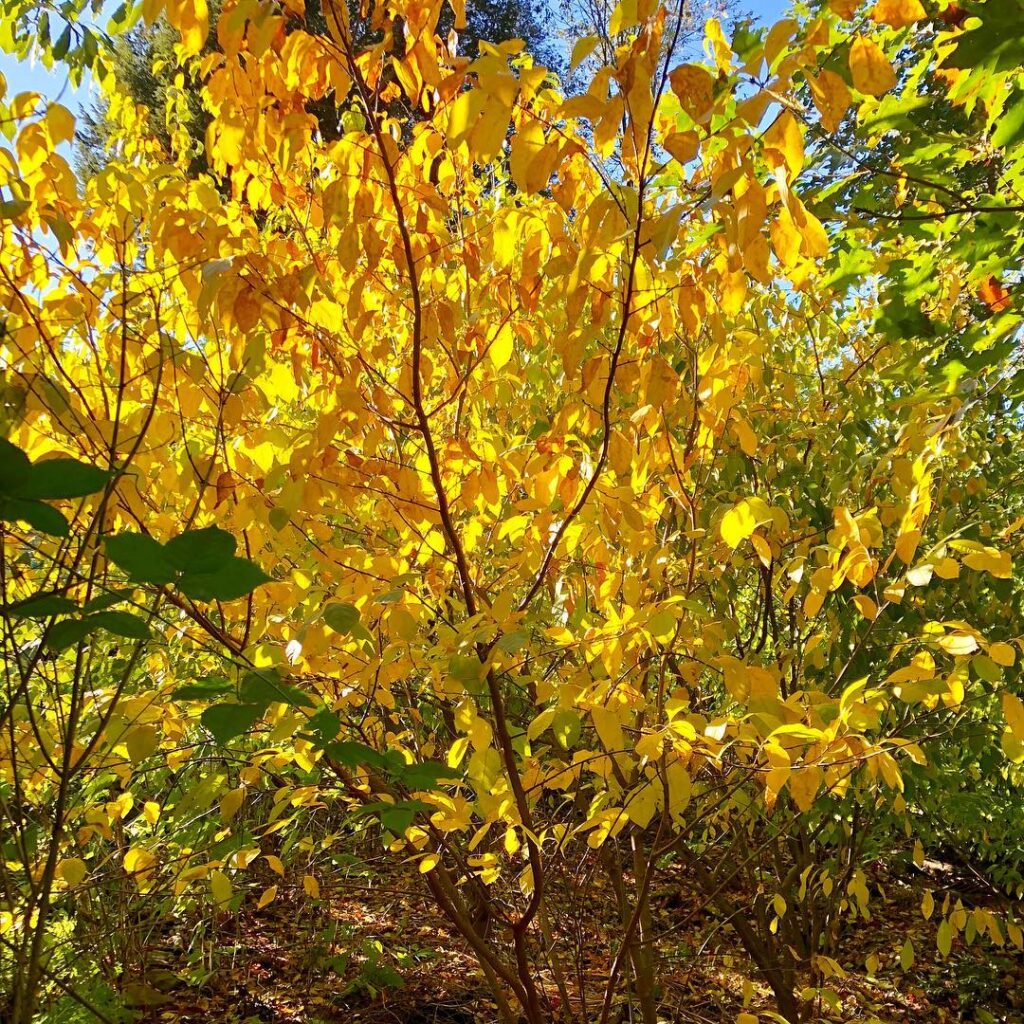
Spicebush (Lindera benzoin) is a versatile deciduous shrub native to eastern North America and common throughout Virginia. This multi-stemmed plant reaches 6-12 feet in height and width, featuring aromatic foliage and cheerful yellow flowers that bloom on bare branches in early spring. The shrub provides three-season interest with spring blooms, summer foliage, and brilliant yellow fall color accompanied by bright red berries on female plants.
As a facultative wetland species, spicebush thrives in diverse environments from streambanks to drier upland sites. It serves exceptional ecological value as a host plant for spicebush swallowtail butterflies while providing early nectar for pollinators and fall berries for songbirds. Its deer-resistant nature and adaptable growing requirements make it ideal for naturalized woodland gardens, mass plantings, and native landscape designs. The ground fruits can be used as a substitute for allspice in culinary applications.
- Hardiness: USDA zones 4-9
- Light: Full sun to full shade; prefers partial shade
- Water: Moist, well-drained soil; tolerates wet conditions and occasional drought
- Soil: Adaptable to various pH levels (acidic to slightly alkaline); prefers rich, organic soils
- Fertilizer: Low maintenance; benefits from organic matter but rarely needs supplemental feeding
- Pest/Disease Resistance: Excellent; deer and rabbit resistant with few serious pest or disease issues
- Growth Rate: Moderate
Elderberry (Sambucus Canadensis)
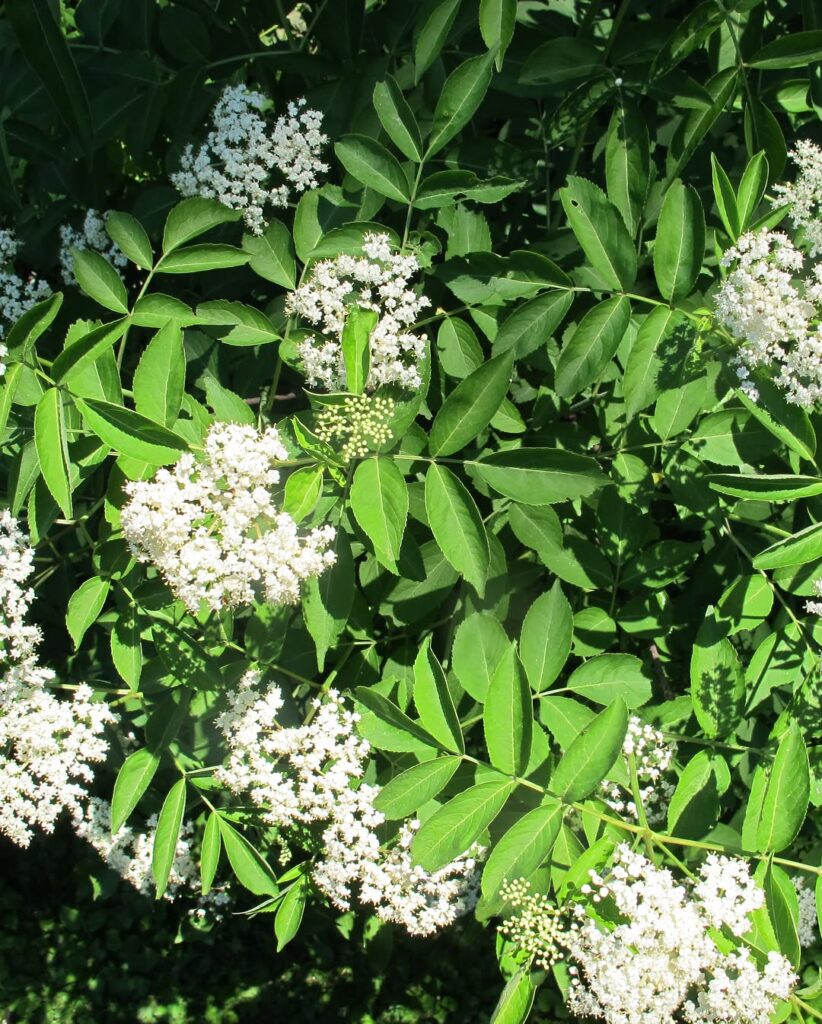
Elderberry (Sambucus canadensis) is a vigorous native shrub reaching 4-15 feet tall with an equal spread. This hardy species produces fragrant white flower clusters from June through July, followed by dark purple-black berries in late summer. Known for its aggressive spreading habit through root suckers, elderberry forms dense thickets that provide excellent wildlife habitat.
The shrub’s pinnately compound leaves and showy blooms make it an attractive ornamental choice, while its berries and flowers offer culinary and medicinal uses. Elderberry thrives in moist conditions and serves as an important food source for over 40 bird species, making it invaluable for wildlife gardens and naturalized plantings. For optimal berry production, maintain two-year-old canes which are the most productive, while pruning out canes that lose vigor after three years.
- Hardiness: Zones 3-9, native throughout eastern North America
- Light: Full sun to partial shade
- Water: Prefers consistently moist soil, tolerates wet conditions
- Soil: Moist, loamy, or organic soils with pH 5.5-6.5; well-drained preferred
- Fertilizer: Low maintenance, benefits from organic matter
- Pest/Disease Resistance: Moderately deer resistant, generally pest-free
- Growth Rate: Fast-growing, spreads aggressively by root suckers
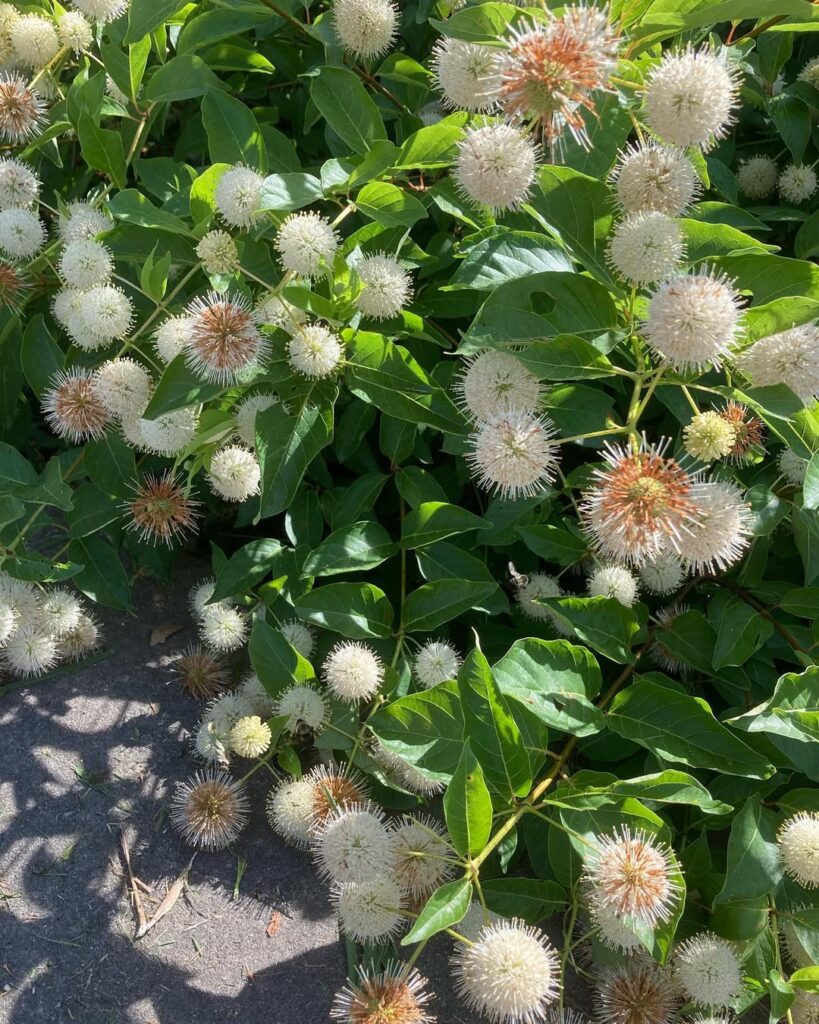
Buttonbush (Cephalanthus occidentalis) is a deciduous native shrub that serves as a cornerstone species for Virginia’s wetland ecosystems. Typically growing 6-12 feet tall with an irregular, spreading crown, this hardy plant produces distinctive white “pincushion” flower clusters from June through August that are magnets for pollinators. The glossy green foliage and persistent ball-shaped fruits provide year-round interest while supporting over 24 bird species and numerous waterfowl that rely on its seeds and shelter.
This low-maintenance shrub excels in consistently moist to wet conditions, making it ideal for rain gardens, shoreline stabilization, and wetland restoration projects. Its ability to tolerate standing water up to 3 feet deep, combined with excellent heat tolerance and adaptability to various soil types, makes buttonbush an invaluable choice for challenging landscape situations where other plants might struggle. The plant’s foliage is poisonous to livestock, making it naturally resistant to browsing by cattle and other farm animals.
- Hardiness: Native throughout Virginia; tolerates heat, soil compaction, and limestone soils
- Light: Part shade to full sun; poor flowering in deep shade
- Water: Consistently moist to wet soils; tolerates standing water up to 3 feet; drought tolerance once established but reduced vigor in prolonged dryness
- Soil: Adaptable to loam, clay, and sandy substrates; prefers circumneutral pH but tolerates range
- Fertilizer: Low fertility requirements; thrives in natural wetland conditions
- Pest/Disease Resistance: Generally pest and disease free; moderately deer-resistant
- Growth Rate: Moderate; reaches mature size of 6-12 feet tall and 8-18 feet wide
Ninebark (Physocarpus Opulifolius)
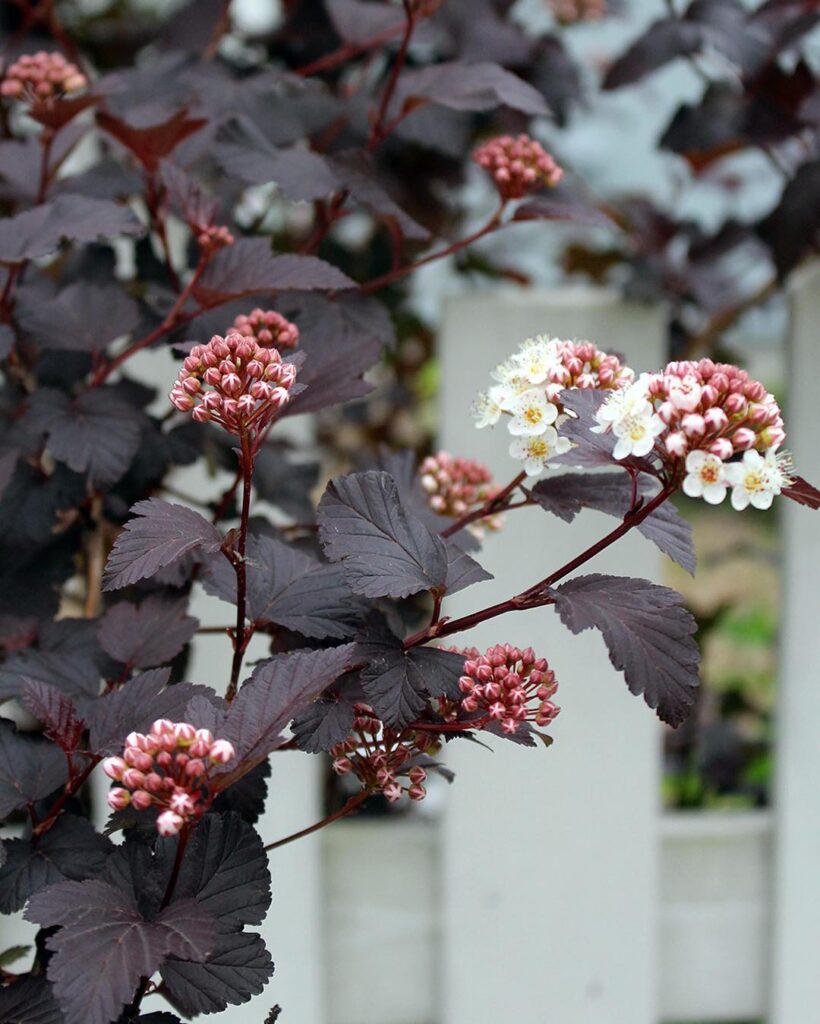
Ninebark (Physocarpus opulifolius) is a versatile deciduous shrub that grows 3-10 feet tall with an attractive mound-shaped form. This Virginia native produces abundant white, spiraea-like flowers in late spring and features distinctive exfoliating bark that reveals reddish-brown underlayers. The plant develops persistent fruit pods that provide winter interest and support for wildlife.
Thriving in diverse habitats from rocky outcrops to stream banks, ninebark is particularly common in Virginia’s mountains and adaptable throughout various landscape settings. Its hardy root system makes it excellent for slope stabilization, while its drought tolerance and low maintenance requirements make it ideal for sustainable landscaping and xeriscaping applications. As a member of the Rosaceae family, ninebark shares characteristics with other beloved flowering shrubs and trees.
- Hardiness: USDA zones 3-7, extremely cold hardy and heat tolerant
- Light: Full sun preferred in northern regions, tolerates partial shade
- Water: Drought tolerant once established, prefers dry to medium moisture levels
- Soil: Adaptable to various soil types, thrives in well-drained, slightly acidic to neutral soils
- Fertilizer: Minimal fertilizer needs, thrives in average soil conditions without supplemental feeding
- Pest/Disease Resistance: Generally pest and disease free, very low maintenance
- Growth Rate: Moderate growth rate, long-lived shrub with arching branch structure
Serviceberry (Amelanchier Canadensis)
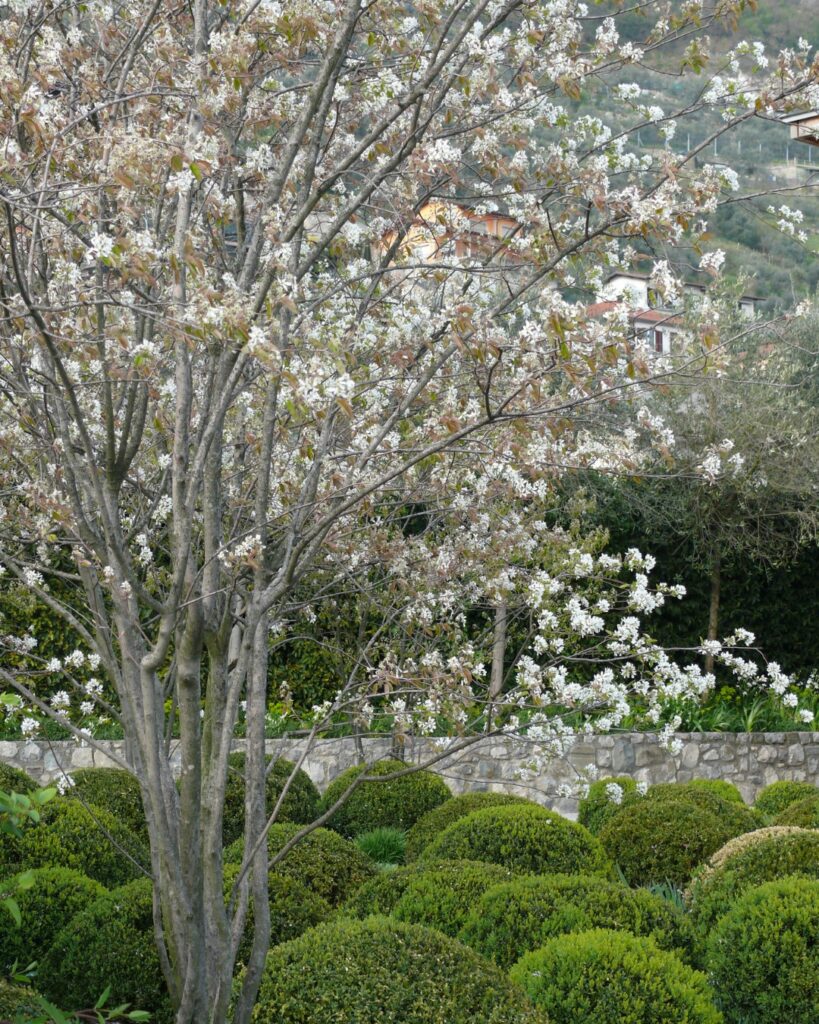
Serviceberry is a versatile deciduous shrub or small tree native to eastern North America, growing 15-25 feet tall with distinctive smooth gray trunks. This multi-season beauty produces fragrant white flowers in early spring before leaves emerge, followed by sweet, edible purple-black berries in summer. The oval leaves turn brilliant red and orange in fall, making it an excellent specimen for naturalized areas, woodland gardens, or as an understory plant.
Seven species of Serviceberry are native to Virginia, with Canadian Serviceberry being among the most common. Also known as shadbush or Juneberry, this adaptable plant thrives in various conditions and provides valuable resources for pollinators and wildlife while offering ornamental appeal throughout three seasons. The serviceberry serves as a high value resource for bees, providing both pollen and nectar during its blooming period.
- Hardiness: USDA zones 4-8, well-adapted to Virginia’s coastal and Piedmont regions
- Light: Part shade preferred; tolerates full sun but benefits from afternoon shade in southern regions
- Water: Moderate to high moisture; adaptable to both wet and dry sites
- Soil: Moist, well-drained sandy loam preferred; tolerates various soil types including some clay
- Fertilizer: Low maintenance; typically requires no supplemental fertilization in appropriate soils
- Pest/Disease Resistance: Generally pest-resistant with good disease tolerance
- Growth Rate: Moderate growth rate, reaching mature size of 15-25 feet over several years
Selecting the Right Native Plants for Your Garden
Before you fall in love with that stunning native azalea at the nursery, you’ll need to understand your garden’s specific conditions to guarantee your plant selections thrive. Start with a thorough site assessment, examining sun exposure, moisture levels, wind patterns, and soil drainage throughout different seasons.
Plant compatibility depends on matching species to your specific microenvironments. Use Virginia’s Native Plant Finder to identify species suited for your exact conditions, whether you’re dealing with dry shade or wet sunny areas. Consider root space requirements, especially in smaller gardens, and evaluate maintenance access and views from windows before finalizing selections.
The Plant Virginia Natives Initiative offers comprehensive regional guides that feature over 100 native species with detailed photos and descriptions to help you make informed choices for your specific area.
Frequently Asked Questions
How Much Do Native Virginia Plants Typically Cost Compared to Non-Native Varieties?
You’ll pay more upfront for native Virginia plants ($7-18 per pot) versus non-natives ($2.50-4), but this cost comparison shows native plant benefits include long-term savings through reduced maintenance needs.
When Is the Best Time of Year to Plant Native Species?
Like medieval gardeners timing their crops, you’ll find spring planting from late March to April ideal for native species establishment. Fall planting in September also works excellently, offering cooler weather and natural rainfall for root development.
How Often Should I Water Newly Planted Native Virginia Plants?
You’ll need different watering frequency during plant establishment phases. Water daily for one week, then every other day week two, every third day week three, and continue every third day monthly.
Do Native Plants Require Special Fertilizers or Soil Amendments?
You don’t need special fertilizers for native plants since they’re adapted to Virginia’s soils. Native plant benefits include thriving without synthetic feeds. If you’re amending soil, use organic fertilizers like compost instead.
Where Can I Purchase Authentic Native Virginia Plants in My Area?
You can purchase authentic native Virginia plants from local nurseries like Hummingbird Hill in Charlottesville or Nature by Design in Alexandria. Online retailers such as Garden for Wildlife and Green Steeze offer convenient shopping options.
